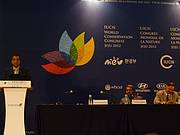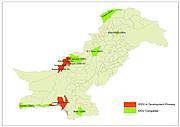Sharing experiences of bottom-up planning: Integrated District Development Visions in Pakistan
10 September 2012 | News story
Balochistan Province is rich in minerals and natural resources, but lacks strategic planning documents and has been embroiled in several internal and external conflicts. This situation presents significant challenges for sustainable development.
The Integrated District Development Visions (IDDVs) are the result of extensive consultative process undertaken in several districts of Pakistan and facilitated by IUCN Pakistan. The resulting five IDDVs in Balochistan address identified priority sectors like poverty alleviation, livelihood diversification, natural resource management, disaster management, health and education, and have proved successful tools not only for planning but also for financing and implementing priority measures.
The Government of Pakistan and IUCN jointly completed the Pakistan National Conservation Strategy in 1992 to strengthen environmental governance in the country facing continuing degradation of its resources. Many stakeholders realized that local level issues require prioritization and development planning in an integrated manner to ensure equitable and sustainable development. With the Local Government Ordinance of 2001 districts are required to have strategies. Based on its experience with facilitating planning processes at all levels and its local engagement, IUCN has assisted eleven districts in developing their IDDVs.
IDDV preparation represents a new approach to planning in an organised manner at district level. It is the first serious effort at the local level to integrate environmental concerns into the development agenda. IDDV Development Committees are set up to oversee and guide the process in each district. The visions provide a framework for economic progress, human capital development and environmental sustainability in the District’s future course of action. After approval by the District Councils, these are legally protected documents. Synthesizing the experiences, a Handbook was published to provide guidance on the processes and mechanisms required to develop an IDDV to the full scale of stakeholders.
The development of IDDVs has resulted in a range of successes. Firstly, the vision looks beyond the normal tenure of a local government, calling for coordination between departments in the district as well as the province, and for an integrated approach that optimally utilizes human and financial resources. Secondly, the IDDV model was developed for people at every level of governance to have access to the tools of environmental governance. Good governance is embodied in the participatory process itself. Thirdly, the process emphasises planning to improve the implementation of sustainable development. Therefore, after IDDV approval, a multiplicity of stakeholders is invited to partner with IUCN to implement approaches and provide funds for sectoral interventions based on IDDV recommendations. In Bagh Viala, for example, nine partners got engaged for transformation it into a ‘green village’. In Qwadar, all four PC-1 (mandated proforma for development projects), which were formulated after training on revised formal provided by IUCN and were based on priorities from IDDVs, were funded.
Finally, this innovative planning process and its successes in the politically instable and environmentally fragile context of Balochistan exemplify that development targets including the global MDGs can only be achieved if adequate planning is undertaken and implemented at the local level. The process also contributes to building required capacities through capitalising on the potential of resource mobilisation and development of action plans.
Overall, IDDVs operationalise sustainable development frameworks for local demands.
For more information:
Please visit www.iucn.org/pakistan and contact Miriam Kugele: Miriam.kugele@iucn.org




